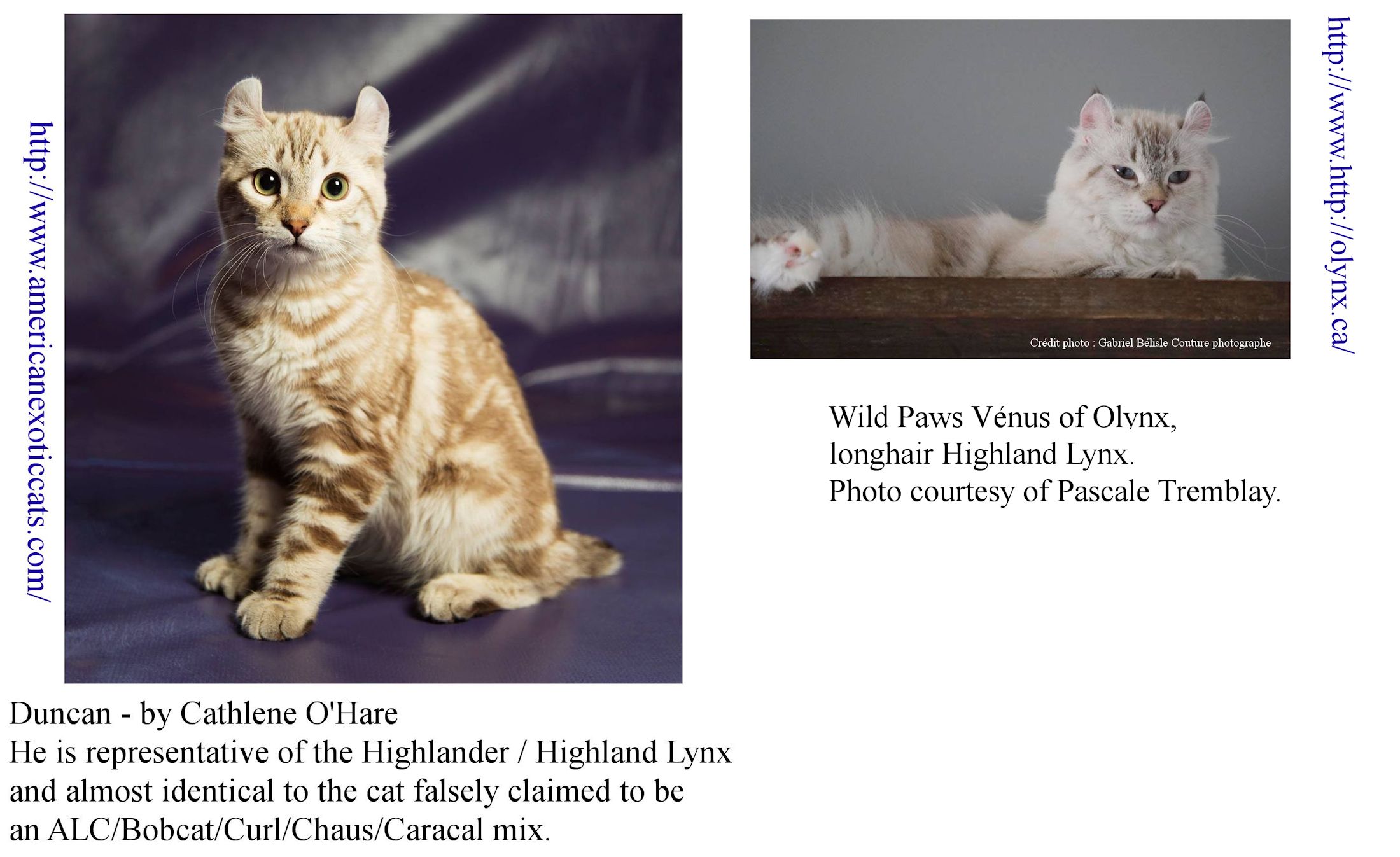
CONSUMER ALERT – THE ALLEGED ASIAN LEOPARD CAT – BOBCAT – JUNGLE CAT – CARACAL MIX
Sarah Hartwell, 2018
The other day I received an email about a cat claimed to be a hybrid of 4 exotics and one domesticated breed. This cat is 15 lbs, her father and brothers were supposedly 25 lbs and her mother supposedly 18 lbs. That is large for a domestic, but not impossible, especially for a muscular cat.
She was supposedly 50% Asian Leopard Cat (ALC), 25% American Curl; 12.5% Bobcat; 6.25% Caracal and 6.25% Jungle Cat.
The photo showed a snow (colourpoint) tabby Highlander – to use the TICA name. This breed is also known as the Highland Lynx in REFR and was originally believed to have Bobcat ancestry (this was disproven by testing). The Highlander is a curl-eared, bob-tailed cat. This particular Colourpoint Highlander has a pale golden brown classic tabby markings and the limbs have much darker tabby markings. Because she is colourpoint, she also has blue eyes.

The owner insisted that the breed and species composition was as stated and that the cat had been DNA tested and that the breeder was “private.” The DNA test certificate was not posted to support those claims. The breeder is evidently so private that his/her name cannot be given. This rings many alarm bells. It means that either the person making the claims is mistaken, has been misled or is a fantasist, or that the unnamed breeder is not a reputable breeder and has sold cats with false claims about their ancestry.
Let’s inject some facts into this.
Any cat that is 50% Asian Leopard cat is an F1 Bengal. No ifs, no buts, you can only get 50% ALC from breeding an ALC to a domestic cat. Because F1, F2 and F3 males are sterile, you cannot preserve 50% ALC genes by breeding F1 to F1. But this cat cannot be 50% ALC for reasons very obvious to anyone with knowledge of cat genetics.
It cannot be 50% ALC because it is colourpoint. Colourpoint is a recessive domestic cat gene. That means that both parents must carry at least one copy of the colourpoint gene in order to have colourpoint offspring. Therefore, this cat isn’t 50% ALC because the ALC does not have the colourpoint gene.
In addition, the cat in the photos is classic tabby – a recessive pattern of domestic cats. F1 Bengals (50% ALC) have spotted or rosette patterns because the ALC does not carry the gene for classic tabby. Classic tabby only shows up in later generations when both parents carry the recessive gene.
Now the Bobcat claim. Despite the owners assertions, there are no verified Bobcat hybrids. At one time REFR claimed that its “Lynx” breeds were around 12.5% Bobcat, basing its claims on observations of Bobcats and domestic cats mating. DNA testing proved that none of the breeds contained Bobcat markers. No claimed Bobcat hybrid has ever proven to have Bobcat genes. Some cats may superficially resemble Bobcats, but they are not hybrids. Even though male Bobcats and female domestic cats have allegedly been observed to mate, the kittens that were seen later were pure domestic – meaning that the female later mated with a domestic tomcat.
Now for the Caracal claim. There have been caracal hybrids in the USA (where the owner of this cat is based) but they were bred only to F2 before the breeder died and the cats were dispersed by her family (who had no interest in continuing her work). I know several breeders who tried unsuccessfully to get hold of the very few female “Caracats.” The hybrids cost $5000 - $20,000 each. Currently the only breeding Caracats are in Russia and are also at the F2 stage. Neither breeding programme has progressed to F3 or further.
In fact the only claims that could be accurate are American Curl and Jungle Cat, because the Jungle Cat (F chaus) was used to create the Chausie breed and this breed has been used to create other breeds. This tallies with the REFR definition of the Highland Lynx’s origins.
Here’s what RER say about the Highland Lynx: “Highland Lynx cats were developed by crossing two existing breeds--Desert Lynx cats and Jungle Curls. .. . Males are larger than females and slower to mature. These cats come in both long and short hair..” and “Through generations of selective breeding with different breeds of domestic cats, the breed group (Desert Lynx, Highland Lynx, Mohave Bob, and Alpine Lynx) has incorporated many characteristics similar to those of the bobcat. . . . There are several breeds of cats whose origins are speculated to be intertwined with the bobcat. The most common ones are the Pixie Bob and those breeds in the Desert Lynx breed group (Desert Lynx, Highland Lynx, Mohave Bob, and Alpine Lynx). It is important to note that DNA testing on these cats has failed to show positive results for the presence of bobcat DNA. There is no evidence of feral ancestry in these cats.” “While the Desert Lynx today is a completely domestic cat, it is bred to resemble the bobcat.”
The aforementioned Jungle Curl is the curl-eared version of the Jungle Lynx, an REFR breed developed using F chaus (Jungle Cat). Jungle Lynx and Jungle Curls are tall cats with ticked, spotted or marbled patterns.
To me (and I’ve studied cat genetics for over 30 years now, including domestic x wild hybrid) it sounds as though someone is out to make a quick buck from an impossible cat. Cat geneticists would love to see a report directly from an accredited lab and not misinformed hype. In which case maybe they are selling Manx cats as cabbits …. Or IRCA Ragdolls with skunk genes …..
Photo credits: Cathlene O'Hare - Highland Lynx, Mohave Bob and Highlander cats.
And: Pascale Tremblay - Pixie-Bob, Highland Lynx and Mohave Bob
|
MESSYBEAST : SMALL CAT HYBRIDS, BRITISH BIG CATS & PREHISTORY |
You are visitor number